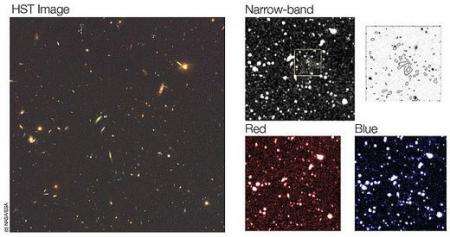Falling onto the dark

ESO's VLT (Very Large Telescope) has helped scientists to discover a large primordial 'blob', more than 10 billion light-years away. The most likely scenario to account for its existence and properties is that it represents the early stage in the formation of a galaxy, when gas falls onto a large clump of dark matter.
Over the last few years, astronomers have discovered in the distant Universe a few so-called 'blobs'. These are rather energetic but under-luminous objects, of the size of or much larger than our Milky Way galaxy. Their exact nature is still unclear and several scenarios have been proposed to account for their existence.
An international team of astronomers have discovered a new 'blob' located at a distance of 11.6 billion light-years (redshift 3.16). It is thus seen as it was when the Universe was only 2 billion years old, or less than 15% its present age. The newly discovered object is located in the well-studied GOODS South field.
The object was discovered using the multi-mode FORS1 instrument on ESO's Very Large Telescope (VLT), in December 2002. The astronomers studied a small part of the GOODS South field in a narrow-band filter centred around 505 nm for more than 8 hours. This special filter allows astronomers to observe emission from hydrogen atoms that are around 11.6 billion light-years away (redshift between 3.126 and 3.174). From December 2004 till February 2005, FORS1 was used again to perform spectroscopy of some of the newly discovered sources, for a total observing time of 6 hours.
With a diameter of 200 000 light-years, the blob is twice as big as our Milky Way and the total energy emitted is equivalent to that of about 2 billion suns. Despite this, the object is invisible in the images taken with various telescopes observing from the infrared to the X-ray wavebands, making it a very peculiar object indeed. It is also the only such object found by the astronomers in their survey.
"We have tried to explain this blob using the most common explanations, such as the illumination by a galaxy with an active nucleus or a galaxy that produce stars at a frantic rate, but none of them apply," says Kim Nilsson (ESO), first author of the paper relating the result. "Instead, we are led to the conclusion that the observed hydrogen emission comes from primordial gas falling onto a clump of dark matter. We could thus be literally seeing the building up of a massive galaxy, like our own, the Milky Way."
Source: European Southern Observatory



















